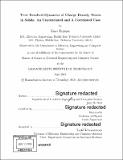| dc.contributor.advisor | Nuh Gedik. | en_US |
| dc.contributor.author | Ergeçen, Emre. | en_US |
| dc.contributor.other | Massachusetts Institute of Technology. Department of Electrical Engineering and Computer Science. | en_US |
| dc.date.accessioned | 2019-11-04T20:22:41Z | |
| dc.date.available | 2019-11-04T20:22:41Z | |
| dc.date.copyright | 2019 | en_US |
| dc.date.issued | 2019 | en_US |
| dc.identifier.uri | https://hdl.handle.net/1721.1/122756 | |
| dc.description | Thesis: S.M., Massachusetts Institute of Technology, Department of Electrical Engineering and Computer Science, 2019 | en_US |
| dc.description | Cataloged from PDF version of thesis. | en_US |
| dc.description | Includes bibliographical references (pages 47-50). | en_US |
| dc.description.abstract | Charge density wave (CDW) is a periodic charge modulation in a metal, induced by electron-phonon or electron-electron interaction, which breaks the translational symmetry of the underlying electron gas. The charge density wave order is ubiquitous among condensed matter systems, and its equilibrium properties have been well characterized by static probes, such as X-ray scattering. However, little is known about their nonequilibrium properties following photoexcitation. In this thesis, we use time resolved optical measurements to characterize the nonequilibrium dynamics of charge density wave systems. In the time resolved optical experiments in this work, an ultrashort (< 100 fs) pump pulse perturbs the CDW system out of equilibrium, and another ultrashort pulse probes the changes in reflectivity following the photoexcitation. We focus on two solids with charge density wave order, La₁.₈₇₅Ba₀.₁₂₅CuO₄ and LaTe₃. First, using transient optical spectroscopy, we studied the photo-induced suppression of CDW state in a phonon driven CDW compound, LaTe₃. We observed that the time to suppress the CDW order is maximal at the threshold photoexcitation density, where the CDW order is completely suppressed. Second, we investigate the collective modes of CDW in La₁.₈₇₅Ba₀.₁₂₅CuO₄, a strongly correlated electron system where electron-electron interactions are responsible for CDW formation. We observe highly damped oscillations in the transient optical response of La₁.₈₇₅Ba₀.₁₂₅CuO₄ below its charge ordering temperature. Using Landau-Ginsburg free energy analysis, we show that the structural origin of these oscillations can explain the temperature independence of the oscillation frequency. Our experimental observations offer an insight into the nonequilibrium properties of charge density wave systems. | en_US |
| dc.description.statementofresponsibility | by Emre Ergeçen. | en_US |
| dc.format.extent | 50 pages | en_US |
| dc.language.iso | eng | en_US |
| dc.publisher | Massachusetts Institute of Technology | en_US |
| dc.rights | MIT theses are protected by copyright. They may be viewed, downloaded, or printed from this source but further reproduction or distribution in any format is prohibited without written permission. | en_US |
| dc.rights.uri | http://dspace.mit.edu/handle/1721.1/7582 | en_US |
| dc.subject | Electrical Engineering and Computer Science. | en_US |
| dc.title | Time resolved dynamics of charge density waves in solids : an uncorrelated and a correlated case | en_US |
| dc.type | Thesis | en_US |
| dc.description.degree | S.M. | en_US |
| dc.contributor.department | Massachusetts Institute of Technology. Department of Electrical Engineering and Computer Science | en_US |
| dc.identifier.oclc | 1124923098 | en_US |
| dc.description.collection | S.M. Massachusetts Institute of Technology, Department of Electrical Engineering and Computer Science | en_US |
| dspace.imported | 2019-11-04T20:22:40Z | en_US |
| mit.thesis.degree | Master | en_US |
| mit.thesis.department | EECS | en_US |
